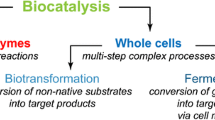Abstract
Biocatalysis in organic media enables higher concentrations of mostly hydrophobic reagents compared to traditional aqueous reaction systems. The resulting economic and ecologic advantages call for more intensive research efforts to attain deeper understanding of the behaviour of biocatalysts under non-conventional reaction conditions.
Similar content being viewed by others
Literatur
Breuer M, Ditrich K, Habicher T et al. (2004) Industrial methods for the production of optically active intermediates. Angew Chem Int Ed Engl 43:788–824
Faber K (2011) Biotransformations in Organic Chemistry, 6. Aufl. Springer, Berlin
Adlercreutz P (2008) Fundamentals of biocatalysis in neat organic solvents. In: Carrea C, Riva S (Hrsg) Organic Synthesis with Enzymes in Non-Aqueous Media. Wiley-VCH, Weinheim, S. 3–24
Dabulis K, Klibanov AM (1993) Dramatic enhancement of enzymatic activity in organic solvents by lyoprotectants. Biotechnol Bioeng 41:566–571
Spickermann D, Kara S, Barackov I et al. (2014) Alcohol dehydrogenase stabilization by additives under industrially relevant reaction conditions. J Mol Catal B: Enzym, doi: 10.1016/j.molcatb.2013.11.015
Carrea G, Riva S (2000) Properties and synthetic applications of enzymes in organic solvents. Angew Chem Int Ed Engl 39:2226–2254
Laane C, Boeren S, Vos K et al. (1987) Rules for optimization of biocatalysis in organic solvents. Biotechnol Bioeng 30:81–87
Villela Filho M, Stillger T, Müller M et al. (2003) Is logP a convenient criterion to guide the choice of solvents for biphasic enzymatic reactions? Angew Chem Int Ed Engl 42:2993–2996
Jakoblinnert A, Mladenov R, Paul A et al. (2011) Asymmetric reduction of ketones with recombinant E. coli whole cells in neat substrates. Chem Commun 47:12230–12232
Kara S, Spickermann D, Schrittwieser JH et al. (2013) Access to lactone building blocks via horse liver alcohol dehydrogenasecatalyzed oxidative lactonization. ACS Catal 3:2436–2439
Toda H, Imae R, Itoh N (2012) Efficient biocatalysis for the production of enantiopure (S)-epoxides using styrene monooxygenase (SMO) and Leifsonia alcohol dehydrogenase (LSADH) system. Tetrahedron Asymm 23:1542–1549
Buhler B, Bollhalder I, Hauer B et al. (2003) Use of the two-liquid phase concept to exploit kinetically controlled multistep biocatalysis. Biotechnol Bioeng 81:683–694
Ni Y, Hagedoorn PL, Xu JH et al. (2012) A biocatalytic hydrogenation of carboxylic acids. Chem Commun 48:12056–12058
Liang J, Lalonde J, Borup B et al. (2010) Development of a biocatalytic process as an alternative to the (-)-DIP-Cl-mediated asymmetric reduction of a key intermediate of montelukast. Org Proc Res Dev 14:193–198
Author information
Authors and Affiliations
Corresponding author
Rights and permissions
About this article
Cite this article
Hollmann, F., Kara, S. Biokatalyse in unkonventionellen Reaktionsmedien. Biospektrum 20, 100–102 (2014). https://doi.org/10.1007/s12268-014-0412-7
Published:
Issue Date:
DOI: https://doi.org/10.1007/s12268-014-0412-7



